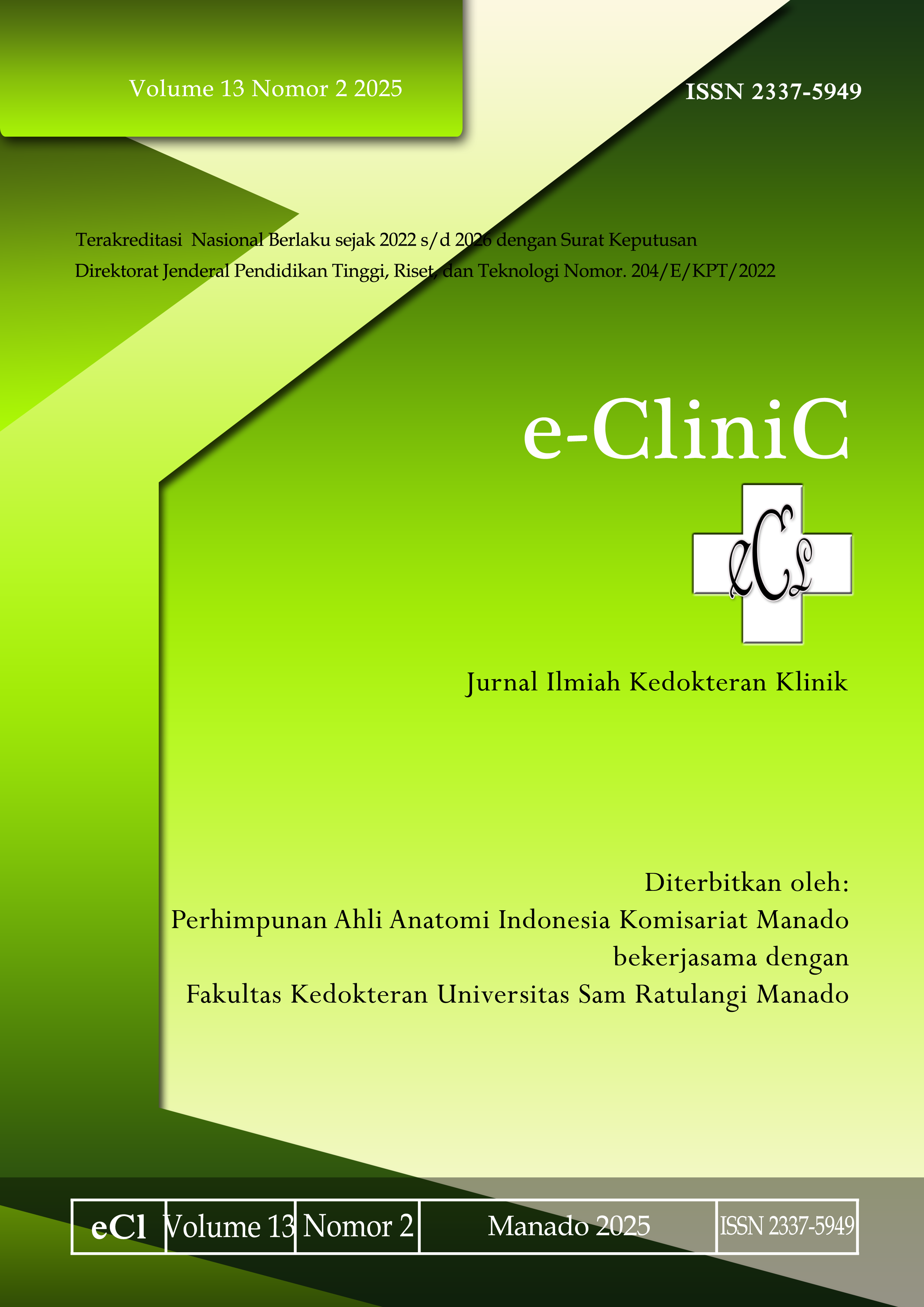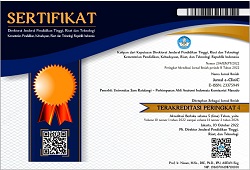Perbandingan Rasio FEV1/FVC pada Mahasiswa Perokok Elektronik dan Perokok Tembakau
DOI:
https://doi.org/10.35790/ecl.v13i2.61014Abstract
Abstract: Tobacco cigarettes and electronic cigarettes contain harmful and toxic chemicals for the body, leading to addiction and dependence on users. Long-term cigarette consumption causes health problems, especially in the respiratory system, marked by disturbances or decreases in lung function. One parameter for measuring lung function is the FEV1/FVC ratio. This study aimed to determine the difference in the FEV1/FVC ratio between electronic and tobacco smokers. This was an analytical and observational study with a cross-sectional design. Samples were students of the Faculty of Civil Engineering, Universitas Sam Ratulangi obtained by using purposive sampling. Data were analyzed using the Mann-Whitney non-parametric independent sample test. The results showed that out of 37 respondents who were electronic cigarette smokers, 33 respondents (89,2%) were in the normal category, and two respondents (5,4%) were in the mild to moderate category. Among tobacco cigarette smokers, out of 46 respondents, 45 respondents (97,8%) were in the normal category, and one respondent (2,2%) was in the moderate category. The Mann-Whitney test revealed a p-value of 0.107 (p>0.05) between the two groups. In conclusion. there is no significant difference in the FEV1/FVC ratio between electronic and tobacco smokers among students at the Faculty of Civil Engineering, Universitas Sam Ratulangi.
Keywords: FEV1/FVC ratio; electronic cigarette smokers; tobacco smokers
Abstrak: Rokok tembakau dan rokok elektronik mengandung bahan kimia berbahaya dan beracun bagi tubuh serta mengakibatkan adiksi dan dependensi pada penggunanya. Konsumsi rokok jangka panjang menyebabkan masalah kesehatan khususnya sistem pernapasan, ditandai gangguan atau penurunan fungsi paru. Salah satu parameter pengukuran kesehatan paru ialah rasio FEV1/FVC. Penelitian ini bertujuan untuk mengetahui perbedaan rasio FEV1/FVC pada perokok elektronik dan tembakau. Jenis penelitian ialah observasional analitik dengan desain potong lintang. Sampel penelitian ialah mahasiswa Fakultas Teknik Sipil Universitas Sam Ratulangi, diperoleh dengan teknik purposive sampling. Alat yang digunakan untuk mengukur rasio FEV1/FVC ialah spirometer. Analisis data menggunakan uji beda sampel bebas non parametrik Mann-Whitney. Hasil penelitian mendapatkan total 37 responden jenis perokok elektronik; 33 responden (89,2%) kategori normal, dua responden (5,4%) kategori ringan - sedang. Perokok tembakau sebanyak total 46 responden; 45 responden (97,8%) kategori normal dan satu responden (2,2%) kategori sedang. Hasil uji Mann-Whitney mendapatkan nilai p=0,107 (p>0,05). Simpulan penelitian ini ialah tidak terdapat perbedaan bermakna antara rasio FEV1/FVC pada perokok elektronik dan perokok tembakau mahasiswa Fakultas Teknik Sipil Universitas Sam Ratulangi.
Kata kunci: rasio FEV1/FVC; perokok elektronik; perokok tembakau
References
Salsabila NN, Indraswari N, Sujatmiko B. Gambaran kebiasaan merokok di Indonesia berdasarkan Indonesia Family Life Survey 5 (IFLS 5). Jurnal Ekonomi Kesehatan Indonesia. 2022;7(1):12. Available from: https://doi.org/10.7454/eki.v7i1.5394
Miranda S, Usraleli U, Masnun M, Delvira W, Rusherina R. Hubungan konsep diri dengan perilaku merokok pada remaja kelas VIII di SMP Negeri 3 Pekanbaru. Jurnal Ilmiah Universitas Batanghari Jambi. 2020 Jul 1;20(2):349. Available from: https://doi.org/10.33087/jiubj.v20i2.941
Raule JH, Koch NM, Antarani AP. Perbedaan pengetahuan gingiviti perokok aktif pria usia 17-45 tahun menggunakan media video. Jurnal Ilmiah Gigi dan Mulut (JIGIM). 2021;4(2):86-90. Available from: 2023;17(6). https://doi.org/10.33578/mbi.v17i6.230
Ambrita MB, Nurhasana R, Ningtyas FR, Shellasih NM, Nadya S. Strategi penurunan angka stunting melalui penyadaran bahaya asap rokok di Tenjolaya, Bogor Jawa Barat. Media Bina Ilmiah . 2023;17(6):1045-50. Available from: https://doi.org/10.33578/mbi.v17i6.230
Waleleng MM, Rotty LWA, Polii E. Perbandingan kadar hemoglobin pengguna rokok elektrik dan rokok konvensional pada pria dewasa di Manado. e-Clinic. 2018;6(2):127-9. Available from: https://www.ucsf. https://doi.org/10.35790/ecl.6.2.2018.22118
Hutapea DSM, Fasya TK. Rokok elektrik (Vape) sebagai gaya hidup perokok masa kini di Kota Lhoksuemawe. Jurnal Ilmu Sosial dan Ilmu Politik Malikussaleh. 2021;2(1):91–108. Available from: https://doi.org/10.29103/jspm.v2i1.3696
Alotaybi M, Alzahrani SS, Algethmi AM, Alamri NS, Natto YS, Hashim ST, et al. E-cigarettes and vaping: a smoking cessation method or another smoking innovation? Cureus. 2022;14(12):e32435. Doi: 10.7759/cureus.32435
Napitupulu RT, Singh B, Citrawati M. Perbandingan nilai volume ekspirasi paksa detik pertama (VEP1) perokok konvensional dengan perokok elektrik. Jurnal Ilmiah Mahasiswa Kedokteran Indonesia. 2020;8(1):27-31. Available from: https://doi.org/10.53366/jimki.v8i1.33
Abdelaal AAM, Mousa GSM. Impact of cigarettes smoking on undergraduates’ lung health and functional performance: observational cross-sectional study. Int J Prev Med. 2022;13(1):59. Doi: 10.4103/ijpvm.IJPVM_308_20
Honeycutt L, Huerne K, Miller A, Wennberg E, Filion KB, Grad R, et al. A systematic review of the effects of e-cigarette use on lung function. NPJ Prim Care Respir Med. 2022;32(1):45. Available from: https://doi.org/10.1038/s41533-022-00311-w
Natalie V, Lontoh SO. Perbandingan fungsi paru antara mahasiswa perokok dan bukan perokok di Fakultas Teknik Universitas Tarumanagara. Tarumanagara Medical Journal. 2020;2(1):167–72. Available from: https://doi.org/10.24912/tmj.v2i2.7857
Soemarwoto RAS, Rusmini H, Sinaga F, Susanto AD, Widiyantoro A. Comparison between the effect of clove, filter and biomass cigarette smoke to the lung function of COPD patients at Harum Melati Pringsewu Clinic period January 2013-2020. Jurnal Respirologi Indonesia [Internet]. 2021;41(1):40-50. Available from: http://www.jurnalrespirologi.org. https://doi.org/10.36497/jri.v41i1.153
Majek P, Jankowski M, Brożek GM. Acute health effects of heated tobacco products: comparative analysis with traditional cigarettes and electronic cigarettes in young adults. ERJ Open Res. 2023;9(3):00595-2022. Doi: 10.1183/23120541.00595-2022
Ariyanto A, Wijayanti Y, Yuniastuti A. An analysis of vital pulmonary capacity, haemoglobin levels and oxygen saturation in conventional electrical smokers. Public Health Perspective Journal. 2018;3(3):185–94. Available from: http://journal.unnes.ac.id/sju/index.php/phpj
Darabseh MZ, Selfe J, Morse CI, Degens H. Impact of vaping and smoking on maximum respiratory pressures and respiratory function. Int J Adolesc Youth. 2021;26(1):421–31. Available from: https://doi.org/10.1080/02673843.2021.1976235
Jatmiko ID, Arbaningsih SR. Perbedaan faal paru antara perokok tembakau dengan perokok elektrik di komunitas Pakam Region Vaporizer. Jurnal Ilmiah Kohesi. 2021;5(4):12-9. Available from: https://kohesi.sciencemakarioz.org/index.php/JIK/article/view/303
Downloads
Published
How to Cite
Issue
Section
License
Copyright (c) 2025 Feren E. I. Korto, Ivonny M. Sapulete, Erwin A. Pangkahila

This work is licensed under a Creative Commons Attribution-NonCommercial 4.0 International License.
COPYRIGHT
Authors who publish with this journal agree to the following terms:
Authors hold their copyright and grant this journal the privilege of first publication, with the work simultaneously licensed under a Creative Commons Attribution License that permits others to impart the work with an acknowledgment of the work's origin and initial publication by this journal.
Authors can enter into separate or additional contractual arrangements for the non-exclusive distribution of the journal's published version of the work (for example, post it to an institutional repository or publish it in a book), with an acknowledgment of its underlying publication in this journal.
Authors are permitted and encouraged to post their work online (for example, in institutional repositories or on their website) as it can lead to productive exchanges, as well as earlier and greater citation of the published work (See The Effect of Open Access).







